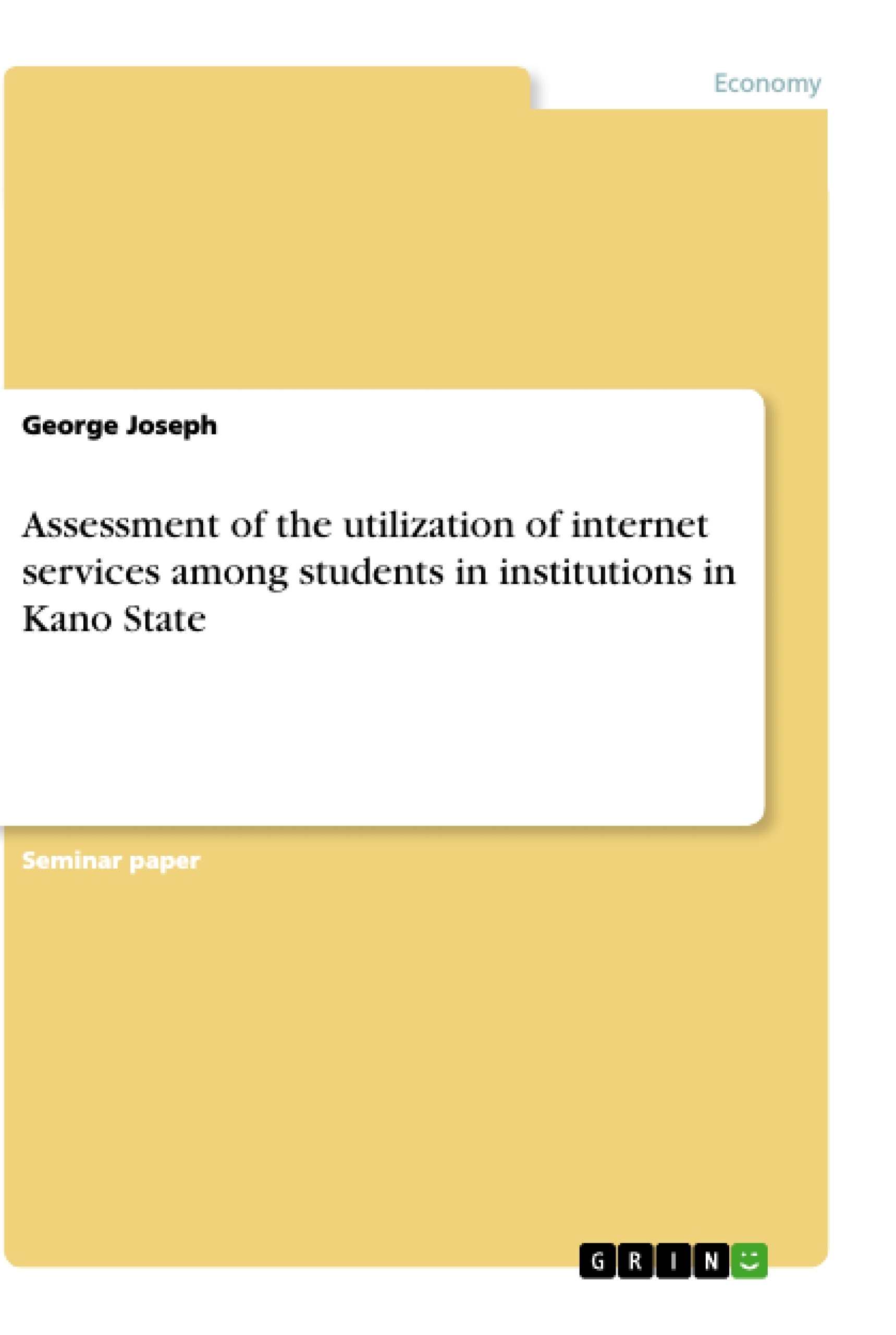This paper is about the assessment of the utilization of internet services among Students in institutions in Kano State.
The emergence of information and communication technologies as typified by the Internet is increasingly having more influence on all aspects of the society as it has become an integral part of the daily lives of many people. It has had a transformative
impact on the mode of information sharing and access globally. Information and knowledge disseminated through the slow process of oral communications or with paper materials can now be transferred rapidly from an individual to an infinite number of users through a number of media and formats.
The Internet is the fastest growing communication technology and has emerged as a major source of information that connects people, data and other computers, reducing the world to the much talked-about global village. Bane and Milhemi described the Internet as the premier networks, everyone connected or as unmanaged web of computer plasma. Technically and functionally, Hargittai defined the Internet as a worldwide network of computers, and a network of people using computers that make vast amounts of information available. Amichai-Hamburger and Hayat described the Internet as the creation of a continuous stream of computers linked together to form one grid, which enables interaction among hundreds of millions of people browsing the net.
Inhaltsverzeichnis (Table of Contents)
- CHAPTER ONE
- INTRODUCTION
- 1.1 Background of the Study.
- 1.2 Statement of the Problem.
- 1.3 Research Questions
- 1.4 Objective of the Study
- 1.5 Significance of the study
- 1.6 Scope and Limitations of the Study.
- 1.7 Definition of Terms.....
- CHAPTER TWO
- LITERATURE REVIEW
- 2.1 Introduction…........
- 2.2 Importance of the Internet in Higher Education.
- 2.3 Internet as a n Information Resource.
- 2.3.1 Impact of the Internet.
- 2.4 Benefits of Using the Internet in Education….....
- 2.5 Awareness of Internet Services
- 2.6 Skills in Using the Internet
- 2.7 Internet-Based Electronic Resources and Services.......
- 2.7.1 Internet services........
- 2.7.2 World Wide Web
- 2.7.3 Web 2.0 technologies
- 2.7.4 Social Networking Sites.
- 2.7.5 Computer-mediated communication...........
- 2.8 Problems Students Experience when using the Internet..\n
- CHAPTER THREE
- RESEARCH METHODOLOGY
- 3.1 Introduction....
- 3.2 Research Method
- 3.3 Sample and Sampling Techniques.
- 3.4 Data Collection Procedures...\n
- 3.4.2 Questionnaires.....
- 3.5 Data Analysis Technique.
- CHAPTER FOUR
- ANALYSIS AND PRESENTATION OF DATA
- 4.1 Introduction...\n
- 4.2 Data Analysis............
- 4.2. 2Age of the respondents..\n
- 4.2.2 Desired areas of training
- 4.3 Access To And Utilisation Of Internet Services.....
- 4.3.1 Access to the internet
- 4.3.2 Duration of internet access per day from different venues
- 4.3.3 Hours of access to online journals.......
- 4.3.4 Frequency of using social networking sites.
Zielsetzung und Themenschwerpunkte (Objectives and Key Themes)
This research project aims to assess the utilization of internet services among students in federal institutions in Kano State. It seeks to understand the extent to which these students access and use internet services, identify the benefits they derive from these services, and explore the challenges they encounter.- Importance and utilization of internet services in education
- Impact of the internet on student learning and engagement
- Access to and usage of internet services among students in Kano State
- Challenges faced by students in utilizing internet services
- Recommendations for improving internet access and utilization in educational institutions
Zusammenfassung der Kapitel (Chapter Summaries)
- Chapter One: Introduction: This chapter provides the background, statement of the problem, research questions, objectives, significance, scope and limitations of the study, and definition of terms related to internet services and education.
- Chapter Two: Literature Review: This chapter explores the existing literature on the importance of the internet in higher education, its impact on students, the benefits of using it in education, and the problems students face when using the internet. It also delves into various internet services, including the World Wide Web, Web 2.0 technologies, social networking sites, and computer-mediated communication.
- Chapter Three: Research Methodology: This chapter outlines the research method, sampling techniques, data collection procedures, and data analysis technique used in the study.
- Chapter Four: Analysis and Presentation of Data: This chapter presents the findings of the study, analyzing data on student demographics, access to and utilization of internet services, duration of access, and frequency of social networking site usage.
Schlüsselwörter (Keywords)
Internet services, higher education, students, utilization, access, benefits, challenges, Kano State, federal institutions, research methodology, data analysis, social networking sites, online journals, Web 2.0 technologies, computer-mediated communication.- Quote paper
- George Joseph (Author), 2019, Assessment of the utilization of internet services among students in institutions in Kano State, Munich, GRIN Verlag, https://www.grin.com/document/1039926



